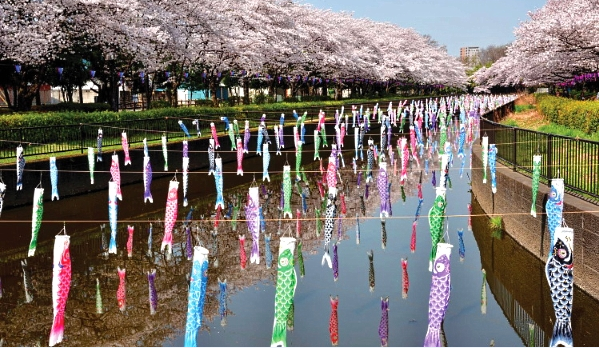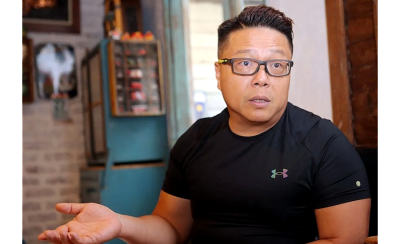By Lee San
In mid-April every year, I would purchase a couple of brightly colored carp streamers and thread them in a string to hang in my courtyard in anticipation of the Japanese Children's Day which falls on May 5.
Foreign students who have lived in Japan for a few years will know that around April and May each year towards the end of the sakura matsuri, colorful carp streamers could be seen fluttering in the wind all across the country, portraying a beautiful and heartwarming family landscape against a backdrop of azure blue sky and pristine white clouds.
During the April sakura matsuri in Tatebayashi city in the suburban Gunma prefecture, some 415 Somei-yoshino cherry trees flanking the banks of Tsuruuda River would start blooming, accompanied by 5,283 brightly colored carp streamers or koinobori swaying graciously in the breeze, and the carps dancing merrily inside the river.

Koinobori is more than just another festive accessory in Japan. Its history could be traced back to 17th century Edo Period traditional folklore that has survived and flourished to this day.
During the olden days, medical facilities were scarce in Japan, and many children could not survive and grow into adulthood due to the high mortality rate. Many parents believed kids younger than seven were borrowed from the deities, and if they fell sick often, they would be taken away by the demons when they turned seven. So parents always thought of ways to stop the demons.
Back then the powerful samurais, eager to keep their children safe at home, were thinking hard for effective solutions. They began to wonder whether the Chinese Confucian belief that "the carp leaps over the Dragon Gate and ascends to heaven becomes the dragon" would actually work. Why not give it a try? So villagers started to create colorful banners in the shape of carps to hang in their yards with the hope this could keep the demons away.
That was actually quite similar to the Chinese tradition of lighting the crackers during lunar new year celebrations to scare away the nian beast.
After the villagers hung the streamers in their yards, the children at home felt the peace and grew up healthily. The news soon spread to other villages and the practice has since been passed down for more than 400 years until today.
However, as the samurais valued their sons much more than daughters, they would only hang the koinobori for boys aged seven, five and three. This tradition lived on until 1948 when the Japanese government enacted a new law to make May 5 Children's Day a national public holiday. Since then Japan began to see new laws to protect children and groom them to become future leaders of the country. The incumbent Japanese prime minister Yoshihide Suga was himself born in the post-war year of 1948. Looks like the "carp leaping over the Dragon Gate" philosophy has worked, huh!
So, I went to Daiso yesterday to buy koinobori of different colors–black symbolizing father, pink symbolizing mother, red symbolizing the eldest son, and blue, yellow and green symbolizing the younger siblings.
And on May 5, the Japanese people will display samurai dolls to commemorate the samurais, along with the Momotaro and Kintaro koinobori to celebrate the day. On this special day, the children will also perform deep bows to their parents for raising them up. In short, this is an auspicious and heartwarming day as Japan's dumpling festival also falls on the same day. Indeed, since the start of the Meiji Restoration in 1868, Japan completely abandoned the lunar calendar which has since been known as the "old calendar".
Talking about the most destructive war in history, when the second world war had just ended on September 2, 1945, Japan as one of the three defeated axis countries, suffered a total of seven million military deaths and 255,000 civilian casualties, with most of the victims being males, including large numbers of children. Additionally, 1.5 million Japanese people decided to emigrate while five million overseas Japanese nationals returned to the country. The post-war population of Japan stood at 72.25 million (126 million today). At that time, the power of Emperor Hiroshi was limited by the US, and the Japanese government rebuilt the war-torn nation with the help of America. The Japanese people were encouraged to have more babies with government incentives. As a result, 2.7 million babies were born in that year alone, and the country's population increased sharply by 10 million in just five years. That's the so-called postwar baby boom.
By comparison there were only 865,234 babies born in 2019, with 100,000 births fewer each year. As if that's not enough, the country is now a rapidly aging society. Those born during the postwar baby boom are now in their 70s.
As a matter of fact, around 27% of Japan's population are aged 65 and above, and they live very long! As for those aged 15 and below, there are only around 15.12 million or 12% of the country's population, and the number is declining every year by an average of 200,000 people. Looks like the Japanese government is having a big headache in the country's population structure with way too many old people and too few children, and this in turn poses a severe challenge for the country's social protection system, medical expenditure and declining productivity, not to mention a severe shortage in skilled workforce.
Gazing at the koinobori fluttering in the wind in my yard, I begin to think about my belle in Hokkaido…
(Lee San is Founder and Group Executive Chairman of Apple Vacations. He has traveled to 132 countries, six continents, and enjoys sharing his travel stories and insights. He has also authored five books.)
ADVERTISEMENT
ADVERTISEMENT


































